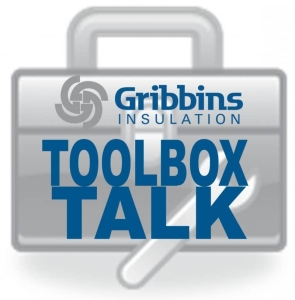Ladders
100% Fall Protection Policy for ladder usage above 6 feet:
Anytime an employee is working from a ladder or climbing a ladder above 6 feet, 100% tie off will be required. If 100% tie off cannot be maintained above 6 feet, other options should be used such as aerial lifts or scaffolds. If 100% tie off cannot be used and the work cannot be accessed by aerial lifts or scaffolds, the foreman shall contact the safety manager to give written permission on how to proceed.
Ladders are a vital part of our work, but present a major safety hazard when used improperly. A poorly maintained or improperly used ladder may collapse under the load place on it and cause the employee to fall. Reasons for injuries while working from ladders include but are not limited to: user wasn’t instructed on how to inspect the ladder, ladder involved broke during use, non-self supporting ladder wasn’t secured at top or bottom, ladder didn’t extend 3 feet above landing level, the ladder involved had more than one defect or ladder was used incorrectly.
Type of ladders include:
- Stepladder – A self-supporting portable ladder that is non-adjustable in length. They shall not be longer than 20 feet, shall be equipped with spreaders of sufficient size and strength to securely hold the front and back sections open, shall not be used as straight ladders
- Single Ladder – A non-self supporting portable ladder that is non-adjustable. They shall not be more than 30 feet
- Extension Ladder – A non-self supporting portable ladder adjustable in length. They shall not be more than 60 feet
General Requirements:
- Ladders shall be placed with a secure footing on an even surface when possible. If this is not possible they shall be secured at the top and bottom to prevent slipping.
- Ladders shall not be used on slippery surfaces or when hands, shoes or rungs are slippery.
- Ladders place in any location where they can be displaced by workplace activities or traffic, such as passageways, doorways or driveways, shall be secured to prevent accidental displacement and/or barricades shall be used to keep the activities or traffic away from the ladder.
- Straight ladders must extend 3 feet above the landing level and be secured. This provides a secure point of support when stepping off the ladder or landing level.
- The ladder shall be angled at a 4 to 1 ratio. 4 feet vertical to 1 foot horizontal.
- Ladders shall not be used to extend the working height on a scaffold.
- The top step or top of a ladder or cross bracing shall not be used as a step.
- Three points of contact shall be maintained while climbing a ladder.
- Always face the ladder and keep yourself in the center of ladder. Belt buckle between rails.
- Make sure surfaces are dry and free of slippery substances.
- Metal ladders shall never be used near electrical equipment.
- The area around the top and bottom of the ladder or stairway shall be kept clear of materials, debris, tools, etc.
- Ladders shall not be moved, shifted or extended while occupied.
- Do not twist your body while working from a ladder, adjust your ladders location instead to gain access to work area.
- Always use handrail when ascending or descending stairways. When carrying materials keep a clear view of the path of travel.
- Do not carry objects, materials, tools or loads up a ladder.
- If a ladder is placed in an area where a fall could propel you over a handrail, 100% fall protection is required. A rule of thumb 1 ft back from the guardrail for every step you are up on the ladder and then add 2 ft to the distance.
Inspections
Ladders shall be inspected before each use before each use for defects and at least quarterly by a competent person. If it is found to be defective it shall be tagged out and removed from service. The inspection should include: checking rungs, braces and top for bends, splits, cracks or other defects, checking locks and guides to insure they are fully functional, checking all hardware items to insure they are functional, checking all metal components for excessive rust or corrosion, checking rivets to insure head and crimp are intact, checking bolts and nuts to insure they are tight and threads are not stripped, checking crimps and swages for looseness, cracking or other conditions, checking welds for cracks or damage, checking safety shoes to insure shoes and treads are in good condition, checking rope and pulley for damage, checking leveling devices for condition and proper operation and checking hooks, grips and lashes for condition and proper operation.



